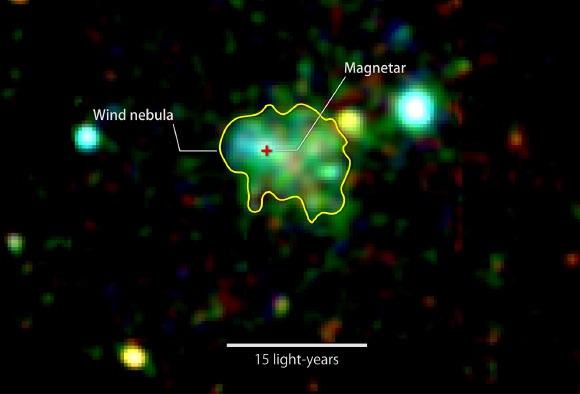Using ESA’s X-ray space observatory XMM-Newton, astronomers have spotted for the first time an enigmatic cloud of high-energy particles called a wind nebula around a magnetar (magnetic neutron star).

This X-ray image shows extended emission around the magnetar Swift J1834.9-0846. The glow arises from a cloud of fast-moving particles produced by the neutron star and corralled around it. Color indicates X-ray energies, with 2,000-3,000 electron volts (eV) in red, 3,000-4,500 eV in green, and 5,000 to 10,000 eV in blue. The image combines observations by XMM-Newton taken on March 16 and October 16, 2014. Image credit: ESA / XMM-Newton / G. Younes et al.
Neutron stars are most commonly found as pulsars, which produce radio, visible light, X-rays and gamma rays at various locations in their surrounding magnetic fields.
Typical pulsar magnetic fields can be 100 billion to 10 trillion times stronger than Earth’s.
Magnetic fields of magnetars reach strengths a thousand times stronger still, and astronomers don’t know the details of how they are created.
Of about 2,600 neutron stars known, to date only 29 are classified as magnetars.
The newly-discovered ‘wind nebula’ surrounds a magnetar known as Swift J1834.9-0846 (J1834.9 for short), which was discovered by NASA’s Swift satellite in August 2011.
XMM-Newton observations of J1834.9 in September 2011, a month after it went into outburst, revealed a very unusual glow about 15 light-years across around the source.
This emission, centered at the magnetar position, was asymmetrical, extending to the south-west of J1834.9.
New XMM-Newton observations in March and October 2014, coupled with archival data from XMM-Newton and Swift, confirm this glow as the first wind nebula ever identified around a magnetar.
“Right now, we don’t know how J1834.9 developed and continues to maintain a wind nebula, which until now was a structure only seen around young pulsars,” said team member Dr. George Younes, from George Washington University.
“If the process here is similar, then about 10% of the magnetar’s rotational energy loss is powering the nebula’s glow, which would be the highest efficiency ever measured in such a system.”
The astronomers suspect J1834.9 is associated with SNR W41, a supernova remnant located about 13,000 light-years away in the constellation Scutum toward the central part of our Milky Way Galaxy.
“For me the most interesting question is, why is this the only magnetar with a nebula,” said Prof. Chryssa Kouveliotou, also from George Washington University.
The most famous wind nebula, powered by a young pulsar, lies at the heart of the Crab Nebula supernova remnant.
Young pulsars rotate rapidly, often dozens of times a second. The pulsar’s fast rotation and strong magnetic field work together to accelerate electrons and other particles to very high energies. This creates an outflow scientists call a pulsar wind that serves as the source of particles making up in a wind nebula.
“Making a wind nebula requires large particle fluxes, as well as some way to bottle up the outflow so it doesn’t just stream into space,” said Dr. Alice Harding of NASA’s Goddard Space Flight Center.
“We think the expanding shell of the supernova remnant serves as the bottle, confining the outflow for a few thousand years. When the shell has expanded enough, it becomes too weak to hold back the particles, which then leak out and the nebula fades away.”
This naturally explains why wind nebulae are not found among older pulsars, even those driving strong outflows.
A pulsar taps into its rotational energy to produce light and accelerate its pulsar wind. By contrast, a magnetar outburst is powered by energy stored in the super-strong magnetic field.
When the field suddenly reconfigures to a lower-energy state, this energy is suddenly released in an outburst of X-rays and gamma rays.
So while magnetars may not produce the steady breeze of a typical pulsar wind, during outbursts they are capable of generating brief gales of accelerated particles.
“The nebula around J1834.9 stores the magnetar’s energetic outflows over its whole active history, starting many thousands of years ago,” said team member Dr. Jonathan Granot, from the Open University in Israel.
“It represents a unique opportunity to study the magnetar’s historical activity, opening a whole new playground for theorists like me.”
The results will be published in the Astrophysical Journal, but have been published on arXiv.org ahead of time.
_____
G. Younes et al. 2016. The wind nebula around magnetar Swift J1834.9-0846. ApJ, accepted for publication; arXiv: 1604.06472







